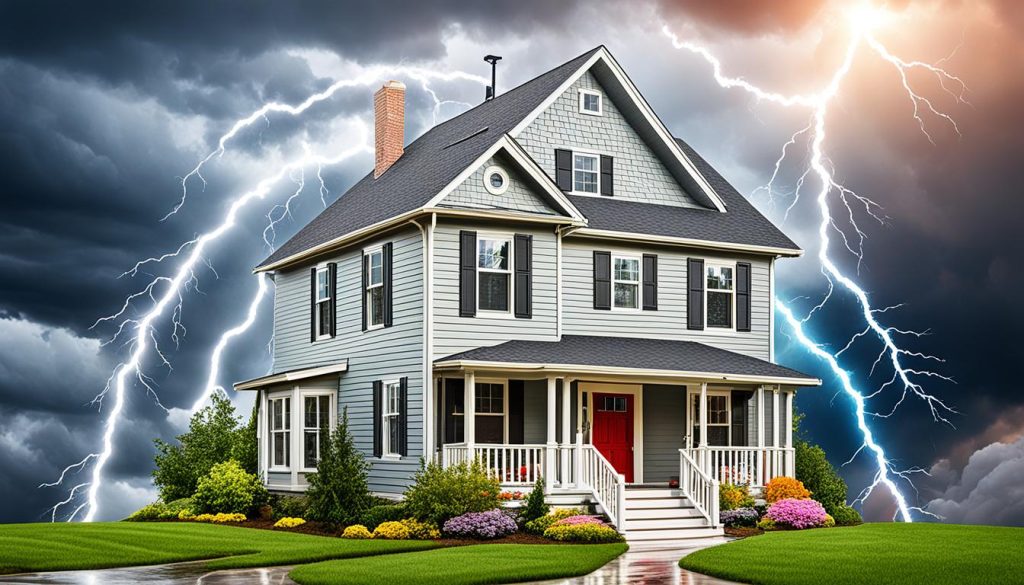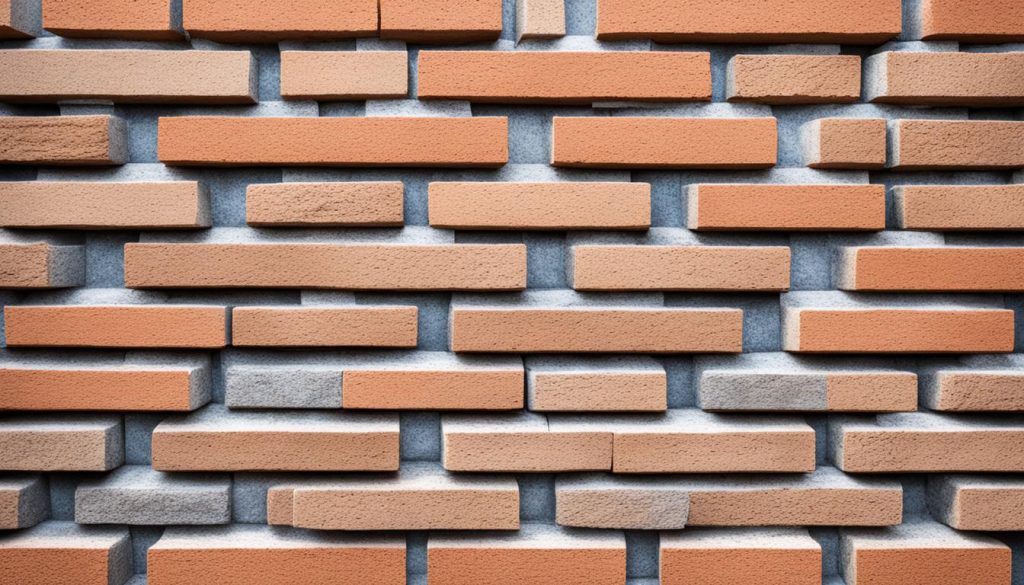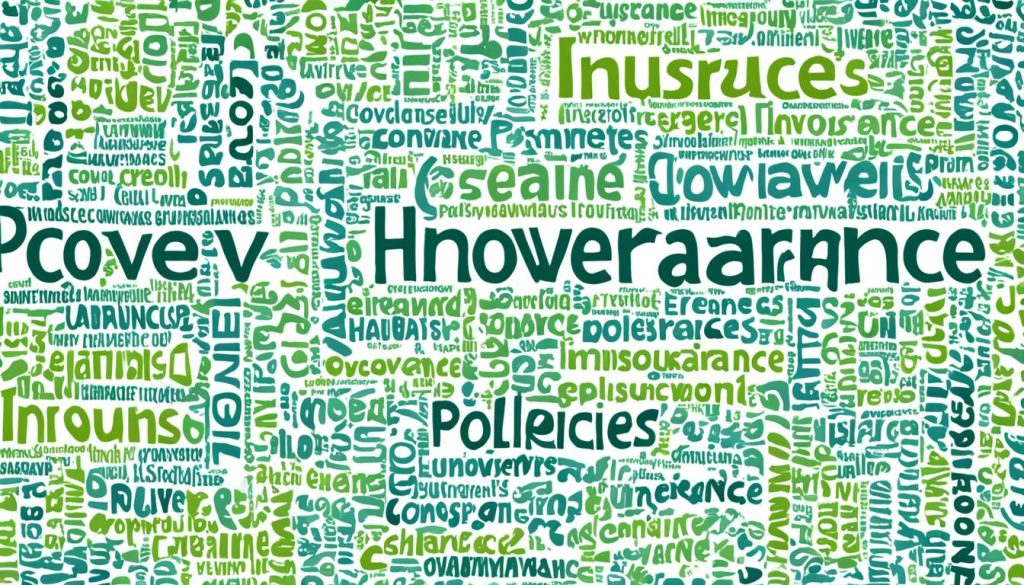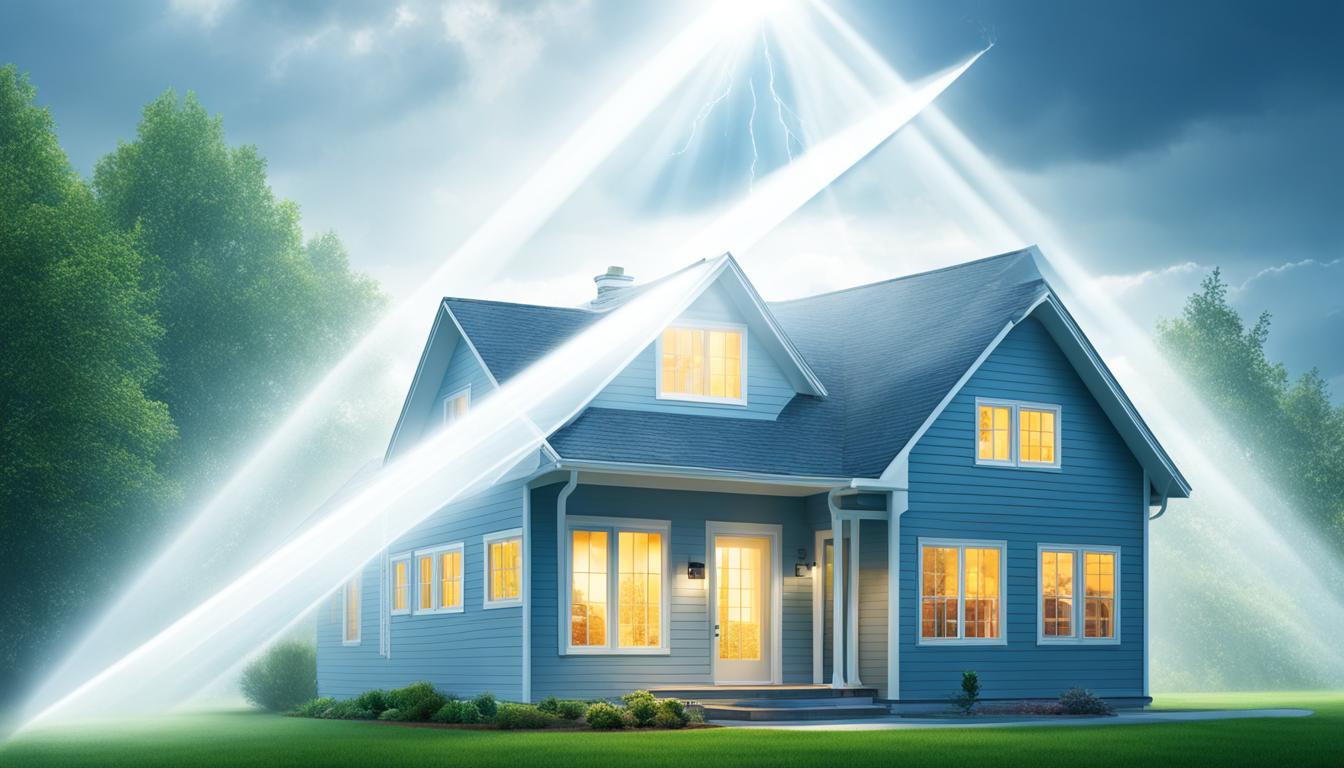Homeowners’ insurance, also known as home insurance, is a critical safeguard that protects our home and possessions. It covers a wide range of risks, including damage to our property, loss or theft of our belongings, and liability for harm to others. When selecting a homeowners’ insurance policy, it’s important to look for key benefits that can maximise the coverage and protection for our home and assets. This article will guide us through the essential components of a standard homeowners’ insurance policy, the different levels of coverage available, and the factors that influence insurance rates, to help us make an informed decision and obtain the best possible protection for our home and financial well-being.
Key Takeaways
- Homeowners’ insurance provides valuable protection for our property, belongings, and liability
- Understanding the key coverage components, such as dwelling, property, and liability, is crucial
- Evaluating different policy levels, such as actual cash value, replacement cost, and guaranteed replacement, can ensure adequate coverage
- Factors like claim history, credit score, and neighbourhood characteristics influence insurance rates
- Regularly reviewing our policy and comparing quotes can help us optimise our coverage and costs
Understanding Homeowners’ Insurance Policies
Homeowners’ insurance policies typically include several key components that provide comprehensive protection. These policies are designed to safeguard both your home and your financial well-being, offering coverage for a wide range of potential risks and damages.
Components of a Standard Policy
The dwelling and property coverage section of a homeowners’ insurance policy covers damage or destruction to the interior and exterior of your home, as well as your personal belongings, due to events like fire, windstorms, and vandalism. This essential coverage helps ensure that your most significant investment is properly protected and can be restored in the event of a covered loss.
Dwelling and Property Coverage
In addition to protecting your physical property, homeowners’ insurance policies also include personal liability protection. This coverage shields you from legal expenses and damages if someone is injured on your property or by your actions, even off-premises. This liability protection can be crucial in preventing costly lawsuits that could otherwise jeopardise your financial security.
Personal Liability Protection
Another key component of a standard homeowners’ insurance policy is the additional living expenses coverage. This provision reimburses you for the costs incurred if you’re forced to temporarily relocate while your home is being repaired or rebuilt after a covered loss. This can include expenses such as temporary housing, meals, and other incidentals, helping to alleviate the financial burden during a difficult time.
Additional Living Expenses
By understanding the comprehensive nature of homeowners’ insurance policies and the specific protections they provide, you can ensure that your home and belongings are properly safeguarded, and your financial well-being is secured in the event of an unexpected disaster or incident.
Types of Homeowners’ Insurance Coverage
When it comes to homeowners’ insurance, there are several levels of coverage to consider, each with its own advantages. Understanding the differences between these options can help you select the policy that best suits your needs and provides the most comprehensive protection for your property.
Actual Cash Value
Actual cash value (ACV) policies cover the current market value of your home and belongings, taking into account depreciation. This means that if you need to file a claim, the insurer will reimburse you for the depreciated value of the damaged or destroyed item, rather than the full replacement cost. While ACV policies tend to have lower premiums, they may not provide sufficient funds to fully restore your home or replace your possessions after a loss.
Replacement Cost
Replacement cost policies, on the other hand, pay to repair or replace your home and personal items without deducting for depreciation. This ensures that you can restore your property to its pre-loss condition, even if the cost of materials and labour has increased since you originally purchased the items. Replacement cost coverage generally comes with higher premiums, but can offer greater peace of mind and financial protection in the event of a claim.
Guaranteed or Extended Replacement Cost/Value
The most comprehensive option is a guaranteed or extended replacement cost/value policy, which covers the full cost of rebuilding your home, even if it exceeds your policy limit. This inflation-buffer coverage can be crucial in ensuring you have sufficient funds to completely restore your home after a major loss, as construction costs can rise significantly over time. While these policies tend to have the highest premiums, they can provide invaluable protection in the event of a catastrophic event.

By understanding the differences between these coverage levels, you can make an informed decision and select the homeowners’ insurance policy that best aligns with your property, budget, and risk tolerance. Carefully evaluating your coverage needs and comparing options from multiple insurers can help you obtain the most comprehensive and cost-effective protection for your home and assets.
What Isn’t Covered by Standard Policies
While homeowners’ insurance policies provide a comprehensive shield for our most valuable asset, our homes, there are certain perils and situations that are typically excluded from standard coverage. Understanding these exclusions is crucial to ensure we have the right protection in place.
Natural Disaster Exclusions
One significant gap in standard homeowners’ insurance is the exclusion of coverage for natural disasters like floods, earthquakes, and sinkholes. These catastrophic events often require separate or supplemental insurance policies to ensure our homes are adequately protected against the devastation they can cause.
Home Maintenance and Repair Costs
Damage resulting from poor home maintenance, such as pest infestations or gradual deterioration, is also generally not included in standard homeowners’ insurance policies. It’s our responsibility as homeowners to stay on top of regular upkeep and repairs to prevent these issues from occurring.
Acts of War, Terrorism, and Nuclear Accidents
Another notable exclusion from homeowners’ insurance policies is coverage for damage caused by acts of war, terrorism, and nuclear accidents. These events, while thankfully rare, can have catastrophic consequences, and homeowners may need to explore additional coverage options to safeguard their properties against such risks.
By understanding the limitations and exclusions of standard homeowners’ insurance policies, we can make informed decisions about the supplementary coverage we may need to fully protect our homes and our financial well-being.
Determining Homeowners’ Insurance Rates
When it comes to homeowners’ insurance, the rates you pay are primarily determined by the insurer’s assessment of the risk associated with your property and your personal profile as a policyholder. Several key factors play a significant role in shaping these insurance premiums, and understanding them can help you secure more favourable rates.
Claim History and Credit Score
One of the most influential factors in determining your homeowners’ insurance rates is your past claim history. Insurers closely examine your track record, looking for any previous claims you’ve filed, as this helps them gauge the likelihood of future claims. Additionally, your credit score is another crucial metric that insurers consider, as it serves as an indicator of your financial responsibility and the potential risk you pose as a policyholder. Maintaining a clean claim history and a good credit score can go a long way in helping you obtain more competitive homeowners’ insurance rates.
Neighbourhood and Crime Rate
The characteristics of your neighbourhood, such as the local crime rate, can also have a significant impact on your homeowners’ insurance premiums. Insurers assess the risk of theft, vandalism, and other property-related crimes in your area, and they may adjust your rates accordingly. Living in a low-crime neighbourhood can help you secure more favourable insurance rates, as the perceived risk of claims is lower.
Building Materials and Availability
The materials used in the construction of your home and the availability of those materials in your local area can also influence your homeowners’ insurance rates. Homes built with fire-resistant or durable materials may qualify for discounts, as they present a lower risk of costly damage. Conversely, homes located in areas where certain building materials are scarce or expensive may face higher insurance premiums, as the cost of repairs and rebuilding could be greater.
By understanding these key factors that shape homeowners’ insurance rates, you can take proactive steps to maintain a clean claim history, improve your credit score, and reside in a low-risk neighbourhood with readily available building materials. This knowledge can empower you to secure more favourable insurance rates and ensure your home is protected with the coverage you need.

Factors Affecting Homeowners’ Insurance Costs
In addition to the factors considered in determining homeowners’ insurance premiums, there are several other variables that can affect the overall cost of a policy. The age and condition of the home, the presence of security systems or other protective devices, the deductible amount chosen, and whether the homeowner purchases additional coverage for valuable items or specific risks can all influence the insurance pricing.
Furthermore, the insurer’s own financial strength and the general state of the insurance market can also play a role in shaping the homeowners’ insurance costs. By regularly reviewing our policy and comparing quotes, we can identify opportunities to optimise our coverage and costs.
| Factors | Impact on Homeowners’ Insurance Costs |
|---|---|
| Home Age and Condition | Older or poorly maintained homes may have higher premiums due to increased risk of claims. |
| Security Systems | The presence of security systems and other protective devices can lead to insurance discounts. |
| Deductible Amount | Choosing a higher deductible can lower the monthly premium, but increases out-of-pocket costs for claims. |
| Additional Coverage | Purchasing coverage for valuable items or specific risks can increase the overall cost of the policy. |
| Insurer’s Financial Strength | Financially stable insurers may offer more competitive premiums. |
| Insurance Market Conditions | Changes in the broader insurance market can impact the costs of homeowners’ coverage. |
By understanding these various cost drivers, we can make informed decisions to optimise our homeowners’ insurance costs and ensure we have the coverage we need to protect our most significant investment – our home.
Choosing the Right Insurance Company
When selecting a homeowners’ insurance provider, it’s important to consider more than just the cost of the premiums. Our priority should be ensuring the insurer offers the specific coverage we require, such as protection for natural disasters or high-value belongings.
Coverage Availability
We must thoroughly review the policy details to confirm the insurer provides the necessary coverage for our unique needs. This may include examining the extent of dwelling and property protection, personal liability coverage, and additional living expenses reimbursement. Researching the availability of optional add-ons or endorsements can also help us tailor the policy to our specific requirements.
Competitive Rates and Discounts
Comparing rates and discounts across multiple providers is crucial to finding the most competitive option. Factors like our claims history, credit score, and the characteristics of our neighbourhood can influence the premiums we’re offered. By exploring various insurers, we can identify opportunities to maximise our savings without compromising on the coverage we need.
Financial Strength and Customer Reviews
Alongside the policy features and pricing, we should also assess the financial stability and customer satisfaction of potential insurers. Reviewing credit rating agency assessments and independent customer satisfaction surveys can provide valuable insights into an insurer’s ability to reliably fulfil their obligations in the event of a claim. Choosing a provider with a strong financial footing and a reputation for excellent service can give us greater confidence in the long-term protection of our home and assets.
By carefully considering the coverage options, rates, discounts, financial strength, and customer reviews of various insurers, we can make an informed decision and select the homeowners’ insurance provider that best meets our needs and offers the optimal protection for our home and assets.
Homeowners’ Insurance Benefits
Homeowners’ insurance provides a range of valuable benefits that can safeguard our home, possessions, and financial well-being. The dwelling and property coverage protects our home and other structures on our property from damage or destruction, while the personal liability protection shields us from legal liability if someone is injured on our property or by our actions. The additional living expenses coverage can reimburse us for the costs of temporary housing and other incidentals if we’re displaced from our home due to a covered loss.
Comprehensive homeowners’ insurance can give us the confidence that our most significant investment and assets are properly protected. The property protection and liability coverage elements of our policy ensure that we’re covered in the event of unexpected incidents, safeguarding our financial security. Furthermore, the living expenses reimbursement feature provides a crucial safety net, allowing us to maintain our standard of living if a covered event forces us from our home.
Homeowners’ insurance is more than just a requirement – it’s a valuable investment in our financial security and peace of mind. By understanding the comprehensive benefits of our policy, we can ensure that our home and belongings are shielded from a wide range of risks, allowing us to focus on enjoying our property without the worry of potential catastrophic losses.

Buying Homeowners’ Insurance
When purchasing homeowners’ insurance, it’s crucial to carefully consider the coverage you need to protect your home and belongings.
Begin by determining the replacement cost of your home and the value of your personal possessions, and choose a policy that provides sufficient coverage to fully restore your property in the event of a loss. Research multiple insurance providers to find the one that offers the best combination of coverage, competitive rates, and financial stability.
Deciding What to Cover
Carefully assess the replacement cost of your home and the value of your personal belongings to ensure you have adequate coverage. This will help you select a policy that can fully restore your property in the event of a covered loss.
Determining Coverage Needs
Evaluate your specific risks and requirements to determine the appropriate level of homeowners’ insurance coverage. Consider factors such as the age and condition of your home, the value of your personal possessions, and any unique features or vulnerabilities that may require additional protection.
Selecting an Insurance Company and Policy
Research multiple insurance providers to find the one that offers the best combination of coverage, competitive rates, and financial stability. Review the policy details, including exclusions and deductibles, to ensure you select the right coverage for your specific needs and budget.

Shopping for Better Rates
To ensure you’re getting the best possible rate on your homeowners’ insurance, it’s advisable to regularly shop around and compare quotes from multiple providers. Rates can fluctuate over time, and a new insurer may be able to offer you a more competitive premium, even if you’ve been with the same company for years.
Regularly Comparing Quotes
Comparing insurance quotes is crucial when shopping for lower homeowners’ insurance rates. Take the time to gather quotes from several reputable insurers to find the most cost-effective coverage that meets your needs. Don’t be afraid to switch providers if a competitor can offer you a better deal.
Considering New Insurers
When switching insurance providers, be open to exploring new options. Established insurers aren’t the only ones who can provide excellent homeowners’ insurance coverage. Newer or lesser-known companies may offer innovative products and competitive rates, so don’t overlook them in your search.
Reviewing Survey Ratings
Before making a decision, be sure to review industry insurance company reviews and customer satisfaction surveys. These can provide valuable insights into the quality of an insurer’s coverage, customer service, and claims handling process. Choosing a provider with a strong reputation can give you peace of mind.
By regularly comparing insurance quotes, considering new insurers, and reviewing survey ratings, you can secure the most comprehensive and cost-effective homeowners’ insurance protection for your property.

Conclusion
Homeowners’ insurance is a critical safeguard that provides essential protection for our home, belongings, and financial security. By understanding the key components of a standard policy, the different coverage levels available, and the factors that influence rates, we can make an informed decision and select the homeowners’ insurance coverage that best meets our needs.
Whether we’re first-time homeowners or have owned a property for years, regularly reviewing our policy, comparing quotes, and choosing the right insurance provider can help us maximise the benefits of homeowners’ insurance and ensure our most significant investment is properly protected. By considering the homeowners’ insurance benefits summary, understanding the key considerations, and taking steps to maximise coverage, we can enjoy the peace of mind that comes with comprehensive protection for our home and assets.
Investing the time to thoroughly evaluate our homeowners’ insurance needs and options is a wise decision that can pay dividends in the long run, safeguarding our financial wellbeing and providing the security we need to fully enjoy the comforts of our home.
FAQ
What are the key components of a standard homeowners’ insurance policy?
What are the different levels of homeowners’ insurance coverage available?
What types of perils and situations are typically excluded from standard homeowners’ insurance policies?
What key factors influence the cost of homeowners’ insurance premiums?
What additional factors can affect the cost of a homeowners’ insurance policy?
What should homeowners consider when selecting a homeowners’ insurance provider?
Source Links
- https://www.investopedia.com/insurance/homeowners-insurance-guide/
- https://www.consumerreports.org/money/homeowners-insurance/buying-guide/
- https://www.usnews.com/insurance/homeowners-insurance/how-to-buy-homeowners-insurance
